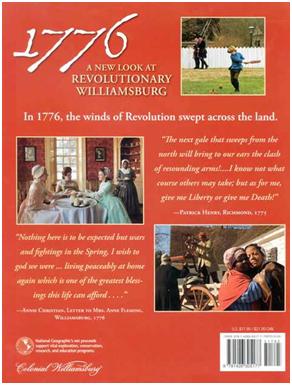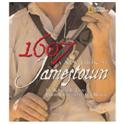 Just published last month! National Geographic has added another title to their outstanding series of photo-books which use re-enactors to depict early American history. 1776: A New Look at Revolutionary Williamsburg
Just published last month! National Geographic has added another title to their outstanding series of photo-books which use re-enactors to depict early American history. 1776: A New Look at Revolutionary Williamsburg
joins earlier titles 1607: Jamestown; 1620: Mayflower; and 1621: Thanksgiving. I hope they will do a companion book on 1775: Lexington & Concord, but perhaps it’s just as well that this volume was published first. Most Americans are unaware of the large role that Williamsburg and Virginia played in the American Revolution. Williamsburg was the capital of the Virginia Colony, of course. George Washington, Thomas Jefferson, and Patrick Henry all spent considerable time there. All three were members of the colonial legislature which met there. Henry and Jefferson were both governors, elected after the colony declared its independence.
 This large-format picture-book is divided into five major sections, with an introduction and an afterword. Part one is a section describing the founding and growth of Williamsburg as the capital of the colony of Virginia. Part two recounts “A New Spirit” and describes the opposition to British rule which grew in the 1760s and had its dramatic high point in Patrick Henry’s speech denouncing the Stamp Act in 1765. Part three is titled “Revolution” and begins with the attempt by the Royal Governor Dunmore to seize the powder reserves of the militia from its storehouse in Williamsburg. It concludes with the passage of the “Declaration of Rights” (written by George Mason) by the Virginia Convention in June of 1776.
This large-format picture-book is divided into five major sections, with an introduction and an afterword. Part one is a section describing the founding and growth of Williamsburg as the capital of the colony of Virginia. Part two recounts “A New Spirit” and describes the opposition to British rule which grew in the 1760s and had its dramatic high point in Patrick Henry’s speech denouncing the Stamp Act in 1765. Part three is titled “Revolution” and begins with the attempt by the Royal Governor Dunmore to seize the powder reserves of the militia from its storehouse in Williamsburg. It concludes with the passage of the “Declaration of Rights” (written by George Mason) by the Virginia Convention in June of 1776.
 Part four describes “The City at War.” Patrick Henry, the first popularly elected governor, replaced Lord Dunmore. The militia assembled and remained camped on the green lawns of Williamsburg, protecting the colonial government from attack by British troops. In 1779, Thomas Jefferson was elected governor and the capital was moved from Williamsburg to Richmond. Part five, “A Hard-Won Victory” describes the arrival of British troops under Benedict Arnold, who sailed by Williamsburg up the James River and sacked Richmond in January of 1781. Arnold retreated through Williamsburg and was then joined by General Cornwallis and his larger body of troops in June. By the end of the summer, Cornwallis had moved his army to Yorktown, about ten miles away from Williamsburg and was soon besieged there by American and French forces under Washington and Lafayette. In October, Cornwallis surrendered.
Part four describes “The City at War.” Patrick Henry, the first popularly elected governor, replaced Lord Dunmore. The militia assembled and remained camped on the green lawns of Williamsburg, protecting the colonial government from attack by British troops. In 1779, Thomas Jefferson was elected governor and the capital was moved from Williamsburg to Richmond. Part five, “A Hard-Won Victory” describes the arrival of British troops under Benedict Arnold, who sailed by Williamsburg up the James River and sacked Richmond in January of 1781. Arnold retreated through Williamsburg and was then joined by General Cornwallis and his larger body of troops in June. By the end of the summer, Cornwallis had moved his army to Yorktown, about ten miles away from Williamsburg and was soon besieged there by American and French forces under Washington and Lafayette. In October, Cornwallis surrendered.
 This volume, like the previous three from National Geographic, makes excellent use of historical settings and dedicated re-enactors who take great pains to get all of the details of their clothes and possessions correct. Colonial Williamsburg is a 300 acre park where the foundation has very carefully restored original buildings from the colonial era. There is something about these stunning color photographs which makes the events much more real. The faces of individuals in the crowd forces us to realize that these were ordinary real people – and that the iconic events of the American Revolution were felt by individuals from all stations of life.
This volume, like the previous three from National Geographic, makes excellent use of historical settings and dedicated re-enactors who take great pains to get all of the details of their clothes and possessions correct. Colonial Williamsburg is a 300 acre park where the foundation has very carefully restored original buildings from the colonial era. There is something about these stunning color photographs which makes the events much more real. The faces of individuals in the crowd forces us to realize that these were ordinary real people – and that the iconic events of the American Revolution were felt by individuals from all stations of life.
 There is a great deal of attention paid in the text and photographs to the ways in which colonial life and the events of the Revolution were experienced differently by the slave community in colonial Virginia. Rightfully so. Without lapsing in a predictable political correctness, there is a refreshing honesty in reporting the reality of the institution of slavery. The tension between the ideals expressed in the Declaration of Independence and the Virginia Declaration of Rights is also noted.
There is a great deal of attention paid in the text and photographs to the ways in which colonial life and the events of the Revolution were experienced differently by the slave community in colonial Virginia. Rightfully so. Without lapsing in a predictable political correctness, there is a refreshing honesty in reporting the reality of the institution of slavery. The tension between the ideals expressed in the Declaration of Independence and the Virginia Declaration of Rights is also noted.
Along with the other titles in this series, National Geographic is doing a fantastic job of making early American history accessible to younger readers. The publisher lists the target age group for this book as “8-12.” The text seems to me to be pitched a little bit older. I’d estimate more like 10-15, but the pictures will certainly grab the attention of younger readers. The content is far more engaging than the accounts in the standard textbooks. I’d certainly recommend this for students up through grades 8 or 9.
1776: A New Look at Revolutionary Williamsburg is a hardback, 48 pages. It is available for $17.95 directly from Greenleaf Press by clicking on any of the links in this review.
– Rob Shearer, Publisher


